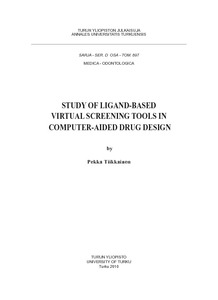Study of ligand-based virtual screening tools in computer-aided drug design
Tiikkainen, Pekka (2010-05-07)
Study of ligand-based virtual screening tools in computer-aided drug design
Tiikkainen, Pekka
(07.05.2010)
Turun yliopisto
Julkaisun pysyvä osoite on:
https://urn.fi/URN:ISBN:978-951-29-4248-0
https://urn.fi/URN:ISBN:978-951-29-4248-0
Kuvaus
Siirretty Doriasta
ei tietoa saavutettavuudesta
ei tietoa saavutettavuudesta
Tiivistelmä
Virtual screening is a central technique in drug discovery today. Millions of molecules can be tested in silico with the aim to only select the most promising and test them experimentally. The topic of this thesis is ligand-based virtual screening tools which take existing active molecules as starting point for finding new drug candidates.
One goal of this thesis was to build a model that gives the probability that two molecules are biologically similar as function of one or more chemical similarity scores. Another important goal was to evaluate how well different ligand-based virtual screening tools are able to distinguish active molecules from inactives. One more criterion set for the virtual screening tools was their applicability in scaffold-hopping, i.e. finding new active chemotypes.
In the first part of the work, a link was defined between the abstract chemical similarity score given by a screening tool and the probability that the two molecules are biologically similar. These results help to decide objectively which virtual screening hits to test experimentally. The work also resulted in a new type of data fusion method when using two or more tools. In the second part, five ligand-based virtual screening tools were evaluated and their performance was found to be generally poor. Three reasons for this were proposed: false negatives in the benchmark sets, active molecules that do not share the binding mode, and activity cliffs. In the third part of the study, a novel visualization and quantification method is presented for evaluation of the scaffold-hopping ability of virtual screening tools.
One goal of this thesis was to build a model that gives the probability that two molecules are biologically similar as function of one or more chemical similarity scores. Another important goal was to evaluate how well different ligand-based virtual screening tools are able to distinguish active molecules from inactives. One more criterion set for the virtual screening tools was their applicability in scaffold-hopping, i.e. finding new active chemotypes.
In the first part of the work, a link was defined between the abstract chemical similarity score given by a screening tool and the probability that the two molecules are biologically similar. These results help to decide objectively which virtual screening hits to test experimentally. The work also resulted in a new type of data fusion method when using two or more tools. In the second part, five ligand-based virtual screening tools were evaluated and their performance was found to be generally poor. Three reasons for this were proposed: false negatives in the benchmark sets, active molecules that do not share the binding mode, and activity cliffs. In the third part of the study, a novel visualization and quantification method is presented for evaluation of the scaffold-hopping ability of virtual screening tools.
Kokoelmat
- Väitöskirjat [3068]
